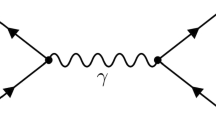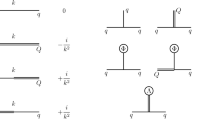Abstract
In a recent work a modified BPHZ scheme has been introduced and applied to one-loop Feynman graphs in non-commutative ϕ 4-theory. In the present paper, we first review the BPHZ method and then we apply the modified BPHZ scheme as well as Zimmermann’s forest formula to the sunrise graph, i.e. a typical higher-loop graph involving overlapping divergences. Furthermore, we show that the application of the modified BPHZ scheme to the IR-singularities appearing in non-planar graphs (UV/IR mixing problem) leads to the introduction of a 1/p 2 term and thereby to a renormalizable model. Finally, we address the application of this approach to gauge field theories.




Similar content being viewed by others
Notes
In the non-commutative setting to be considered in Sects. 3 and 4, this condition obviously has to be relaxed since the star product introduces a certain type of non-localities, see Ref. [1]. However, the condition that the counterterms have the same form as those in the original Lagrangian still applies—see also the discussion in Sect. 3.2.
More generally, one may have integrals over several internal momenta k 1,…,k L .
Actually this formula is tantamount to Dyson’s original prescription of renormalization for non-overlapping divergences [33].
Actually, the s-trick has recently also been implemented via a BRST-doublet, see Ref. [57].
For the sake of simplicity, we assume that the parameter σ appearing in the gauge field propagator of Ref. [54] vanishes, i.e. in the following calculation we neglect an extra non-local counterterm for the singularity (89). Furthermore, for the present illustration we consider a Feynman-like gauge fixing where an additional damping factor is included in order to arrive at the simplest form of the gauge field propagator. We note, however, that the full model of Ref. [54] is based on the Landau gauge fixing, or may be generalized to other gauges along the lines of the recent work [58].
References
D.N. Blaschke, T. Garschall, F. Gieres, F. Heindl, M. Schweda, M. Wohlgenannt, Eur. Phys. J. C 73, 2262 (2013). arXiv:1207.5494
R.J. Szabo, Phys. Rep. 378, 207–299 (2003). arXiv:hep-th/0109162
R. Gurau, J. Magnen, V. Rivasseau, A. Tanasa, Commun. Math. Phys. 287, 275–290 (2009). arXiv:0802.0791
W. Zimmermann, Commun. Math. Phys. 15, 208–234 (1969)
O. Piguet, S.P. Sorella, Lect. Notes Phys., M Monogr. 28, 1–134 (1995)
A. Boresch, S. Emery, O. Moritsch, M. Schweda, T. Sommer, H. Zerrouki, Applications of Noncovariant Gauges in the Algebraic Renormalization Procedure (World Scientific, Singapore, 1998)
E.C.G. Stueckelberg, T.A. Green, Helv. Phys. Acta 24, 153–174 (1951)
A.S. Wightman, Orientation, in Renormalization Theory, ed. by G. Velo, A. Wightman, Proc. of the NATO Advanced Study Institute, Erice, 1975 (Reidel, Dordrecht, 1976)
N.N. Bogoliubov, D.V. Shirkov, Fortschr. Phys. 3, 439–495 (1955)
N.N. Bogoliubov, D.V. Shirkov, Fortschr. Phys. 4, 438–517 (1956)
N. Bogoliubov, O. Parasiuk, Acta Math. 97, 227–266 (1957)
N.N. Bogoliubov, D.V. Shirkov, Introduction to the Theory of Quantized Fields (Wiley, New York, 1980)
K. Hepp, Commun. Math. Phys. 2, 301–326 (1966)
W. Zimmermann, Commun. Math. Phys. 6, 161–188 (1967)
J.H. Lowenstein, Commun. Math. Phys. 47, 53–68 (1976)
W. Zimmermann, Local operator products and renormalization in quantum field theory, in Lectures on Elementary Particles and Quantum Field Theory, ed. by S. Deser, M. Grisaru, H. Pendleton, Proc. 1970 Brandeis Summer Institute in Theor. Phys. (MIT Press, Cambridge, 1971)
W. Zimmermann, Ann. Phys. 77, 536–569 (1973)
J. Lowenstein, M. Weinstein, W. Zimmermann, Phys. Rev. D 10, 1854–1871 (1974)
J.H. Lowenstein, W. Zimmermann, Nucl. Phys. B 86, 77–103 (1975)
J.H. Lowenstein, BPHZ renormalization, in Renormalization Theory, ed. by G. Velo, A. Wightman, Proc. of the NATO Advanced Study Institute, Erice, 1975 (Reidel, Dordrecht, 1976)
J.H. Lowenstein, Nucl. Phys. B 96, 189 (1975)
M. Schweda, J. Weigl, P. Gaigg, Riv. Nuovo Cimento 5(5), 1–54 (1982)
C. Itzykson, J.-B. Zuber, Quantum Field Theory (Dover, New York, 2005)
E.B. Manoukian, Renormalization. Pure and Applied Mathematics (Academic Press, San Diego, 1983)
J.C. Collins, Renormalization: An Introduction to Renormalization, the Renormalization Group and the Operator-Product Expansion. Cambridge Monographs on Mathematical Physics (Cambridge University Press, Cambridge, 1986)
O.I. Zavyalov, Renormalized Quantum Field Theory. Mathematics and Its Applications, vol. 21 (Kluwer, Dordrecht, 1990). Soviet series
V.A. Smirnov, Renormalization and Asymptotic Expansions. Progress in Mathematical Physics (Birkhäuser, Basel, 1991)
T. Muta, Foundations of Quantum Chromodynamics, 2nd edn. World Sci. Lect. Notes Phys., vol. 57 (1998), pp. 1–409
A. Das, Quantum Field Theory (World Scientific, Singapore, 2008)
J.C. Collins, Renormalization: general theory, in Encyclopedia of Mathematical Physics, ed. by J.-P. Francoise, G.L. Naber, T.S. Tsun (Academic Press, Oxford, 2006), pp. 399–407. arXiv:hep-th/0602121
K. Sibold, Störungstheoretische Renormierung, Quantisierung von Eichtheorien. Lecture notes, University of Leipzig. URL http://www.physik.uni-leipzig.de/~sibold/qftskriptum.pdf
K. Fredenhagen, Quantenfeldtheorie. Lecture notes, University of Hamburg. URL http://unith.desy.de/sites/site_unith/content/e20/e72/e180/e61334/e65025/SkriptQFT06.pdf
F.J. Dyson, Phys. Rev. 75, 1736–1755 (1949)
M. Bergère, J.-B. Zuber, Commun. Math. Phys. 35, 113–140 (1974)
O.I. Zav’yalov, B.M. Stepanov, Sov. J. Nucl. Phys. 1, 658 (1965)
M. Sampaio, A. Baeta Scarpelli, B. Hiller, A. Brizola, M. Nemes, S. Gobira, Phys. Rev. D 65, 125023 (2002). arXiv:hep-th/0203261
S. Falk, R. Häußling, F. Scheck, J. Phys. A, Math. Theor. 43, 035401 (2010). arXiv:0901.2252
D.N. Blaschke, F. Gieres, E. Kronberger, T. Reis, M. Schweda, R.I.P. Sedmik, J. High Energy Phys. 11, 074 (2008). arXiv:0807.3270
P.A. Grassi, Nucl. Phys. B 462, 524–550 (1996)
S. Minwalla, M. Van Raamsdonk, N. Seiberg, J. High Energy Phys. 02, 020 (2000). arXiv:hep-th/9912072
W. Heisenberg, Letter to R. Peierls (1930), in Wolfgang Pauli, Scientific Correspondence, vol. II, ed. by K. von Meyenn (Springer, Berlin, 1985), p. 15
W. Pauli, Letter to R. J. Oppenheimer (1946), in Wolfgang Pauli, Scientific Correspondence, vol. III, ed. by K. von Meyenn (Springer, Berlin, 1946), p. 380
H.S. Snyder, Phys. Rev. 71, 38–41 (1947)
H.S. Snyder, Phys. Rev. 72, 68 (1947)
C.N. Yang, Phys. Rev. 72, 874 (1947)
D.N. Blaschke, F. Gieres, E. Kronberger, M. Schweda, M. Wohlgenannt, J. Phys. A, Math. Theor. 41, 252002 (2008). arXiv:0804.1914
A. Micu, M.M. Sheikh Jabbari, J. High Energy Phys. 01, 025 (2001). arXiv:hep-th/0008057
V. Rivasseau, Non-commutative renormalization, in Quantum Spaces—Poincaré Seminar 2007, ed. by B. Duplantier, V. Rivasseau (Birkhäuser, Basel, 2007). arXiv:0705.0705
D.N. Blaschke, E. Kronberger, R.I.P. Sedmik, M. Wohlgenannt, SIGMA 6, 062 (2010). arXiv:1004.2127
H. Grosse, M. Wohlgenannt, Eur. Phys. J. C 52, 435–450 (2007). arXiv:hep-th/0703169
A. de Goursac, J.-C. Wallet, R. Wulkenhaar, Eur. Phys. J. C 51, 977–987 (2007). arXiv:hep-th/0703075
D.N. Blaschke, H. Grosse, M. Schweda, Europhys. Lett. 79, 61002 (2007). arXiv:0705.4205
L.C.Q. Vilar, O.S. Ventura, D.G. Tedesco, V.E.R. Lemes, J. Phys. A, Math. Theor. 43, 135401 (2010). arXiv:0902.2956
D.N. Blaschke, A. Rofner, R.I.P. Sedmik, M. Wohlgenannt, J. Phys. A, Math. Theor. 43, 425401 (2010). arXiv:0912.2634
D.N. Blaschke, Europhys. Lett. 91, 11001 (2010). arXiv:1005.1578
D.N. Blaschke, H. Grosse, J.-C. Wallet, J. High Energy Phys. 06, 038 (2013). arXiv:1302.2903
A. Quadri, J. Phys. G, Nucl. Part. Phys. 30, 677 (2004). arXiv:hep-th/0309133
P.M. Lavrov, O. Lechtenfeld, Phys. Lett. B 725, 386–388 (2013). arXiv:1305.2931
D.N. Blaschke, A. Rofner, M. Schweda, R.I.P. Sedmik, Eur. Phys. J. C 62, 433 (2009). arXiv:0901.1681
Acknowledgements
D.N. Blaschke is a recipient of an APART fellowship of the Austrian Academy of Sciences, and is also grateful for the hospitality of the theory division of LANL and its partial financial support. F. Gieres wishes the express his gratitude to S. Theisen for valuable discussions. M. Schweda thanks C. Becchi for useful comments.
Author information
Authors and Affiliations
Corresponding author
Appendix
Appendix
The purpose of this appendix is to illustrate problems arising for the one-loop polarization (88) associated to the naïve non-commutative gauge field model (85) when applying the s-trick described in Sect. 2.10. Thus, we introduce a mass term involving an auxiliary mass M and an auxiliary variable s in all internal propagators,
and apply the Taylor expansion operator \(t_{p,s}^{\delta(\varGamma)}\) around both p=0 and s=0, while setting s=1 at the end of the calculation so as to discard artificial IR-problems.
For the quadratically divergent integral (88) we have
where we took into account the fact that the integral over an odd function of k vanishes upon integration over symmetric intervals. Thus, the finite part of the vacuum polarization reads
Evaluation of the resulting integral using Schwinger’s parametrization leads to an expression whose planar part is UV-finite, and whose non-planar part involves modified Bessel functions of the second kind. Expansion of the latter around small values of \(\tilde{p}^{2}\) enables us to perform the final parametric integral (i.e. the integral over the Schwinger parameter ξ already considered in (64)). After an expansion around small mass M we finally get
The mass dependent parts are not transversal, but the limit M→0 exists,
and this expression is indeed transversal. These results show already at one-loop level that the introduction of a regulator mass explicitly breaks gauge invariance and violates Slavnov–Taylor identities such as the transversality of the vacuum polarization, see also [39] and references therein. In our specific example, the limit M→0 exists and restores gauge symmetry, but this need not be the case for other graphs. Fortunately, as discussed in Sect. 4, we do not have to consider an infrared regularization using an auxiliary mass for the non-commutative gauge field model of Ref. [54].
Rights and permissions
About this article
Cite this article
Blaschke, D.N., Gieres, F., Heindl, F. et al. BPHZ renormalization and its application to non-commutative field theory. Eur. Phys. J. C 73, 2566 (2013). https://doi.org/10.1140/epjc/s10052-013-2566-8
Received:
Published:
DOI: https://doi.org/10.1140/epjc/s10052-013-2566-8




